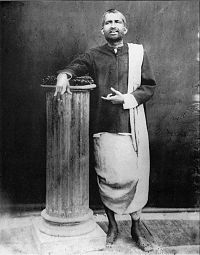User:Goethean/SRK/Teachings/Goethean
Teachings
[edit]God-realisation
[edit]
The key concepts in Ramakrishna’s teachings were the oneness of existence; the divinity of all living beings; and the unity of God and the harmony of religions.
Ramakrishna emphasised that God-realisation is the supreme goal of all living beings.[1] Religion, for him, was merely a means for the achievement of this goal. Ramakrishna’s mystical realisation, classified by Hindu tradition as nirvikalpa samadhi (literally, "bliss without differentiation", thought to be absorption in the all-encompassing Consciousness), led him to know that the various religions are different ways to reach The Absolute, and that the Ultimate Reality could never be expressed in human terms.
Kamini-kanchan
[edit]Ramakrishna taught that that the primal bondage in human life is to kaminikanchan, or "women and gold". Devotees insist that this phrase warns against lust and greed, but religion scholars and historians have tended to take it more literally. He seems to have overcome sexual desires by "becoming female":
- A man can change his nature by imitating another's character. By transposing onto yourself the attributes of a woman, you gradually destroy lust and the other sensual drives. You begin to behave like a women. I have noticed that men who play female parts in the theater speak like women or brush their teeth like women while bathing.[2]
Various scholars have come to opposing conclusions about Ramakrishna's attitude toward women. Some say that he was simply an ascetic and avoided lust in order to retain mystical clarity.[citation needed] Others say that he feared women deeply or pathologically, especially women as sexual beings.[citation needed] Narasingha Sil links this to traditional rural Bengali misogyny.[3] Sil also says that Ramakrishna made his wife into a deity in order to avoid thinking of her as sexual.[4]
Avidyamaya and vidyamaya
[edit]Devotees believe that Ramakrishna’s realisation of nirvikalpa samadhi also led him to an understanding of the two sides of maya, or illusion, to which he referred as Avidyamaya and vidyamaya. He explained that avidyamaya represents dark forces (e.g. sensual desire, evil passions, greed, lust and cruelty), which keep the world-system on lower planes of consciousness. These forces are responsible for human entrapment in the cycle of birth and death, and they must be fought and vanquished. Vidyamaya, on the other hand, represents higher forces (e.g. spiritual virtues, enlightening qualities, kindness, purity, love, and devotion), which elevate human beings to the higher planes of consciousness. With the help of vidyamaya, he said that devotees could rid themselves of avidyamaya and achieve the ultimate goal of becoming mayatita - that is, free from maya.
Harmony of religions
[edit]Ramakrishna recognised differences among religions but realised that in spite of these differences, all religions lead to the same ultimate goal, and hence they are all valid and true. Regarding this, the distinguished British historian Arnold J. Toynbee has written: “… Mahatma Gandhi’s principle of non-violence and Sri Ramakrishna’s testimony to the harmony of religions: here we have the attitude and the spirit that can make it possible for the human race to grow together into a single family – and in the Atomic Age, this is the only alternative to destroying ourselves.” [5]
Other teachings
[edit]Ramakrishna’s proclamation of jatra jiv tatra Shiv (wherever there is a living being, there is Shiva) stemmed from his Advaitic perception of Reality. This would lead him teach his disciples, "Jive daya noy, Shiv gyane jiv seba" (not kindness to living beings, but serving the living being as Shiva Himself). This view differs considerably from what Ramakrishna’s followers call the "sentimental pantheism" of, for example, Francis of Assisi.
Ramakrishna, though not formally trained as a philosopher, had an intuitive grasp of complex philosophical concepts.[6] According to him brahmanda, the visible universe and many other universes, are mere bubbles emerging out of Brahman, the supreme ocean of intelligence [7].
Like Adi Sankara had done more than a thousand years earlier, Ramakrishna Paramahamsa revitalised Hinduism which had been fraught with excessive ritualism and superstition in the Nineteenth century and helped it become better-equipped to respond to challenges from Islam, Christianity and the dawn of the modern era[8]. However, unlike Adi Sankara, Ramakrishna developed ideas about the post-samadhi descent of consciousness into the phenomenal world, which he went on to term "vignana". While he asserted the supreme validity of Advaita Vedanta, he also he accepted both the Nitya (or the eternal substance) and the Leela (literally, "play", indicating the dynamic phenomenal reality) as aspects of Brahman.
The idea of the descent of consciousness shows the influence of the Bhakti movement and certain sub-schools of Shaktism on Ramakrishna’s thought. The idea would later influence Aurobindo's views about the Divine Life on Earth.
Notes
[edit]- ^ Kathamrita, 1/10/6
- ^ Parama Roy, Indian Traffic: Identities in Question in Colonial and Post-Colonial India Berkeley: University of California Press, 1998
- ^ Sil, Divine Dowager, p. 52
- ^ Sil, Divine Dowager, p. 55
- ^ Contributions of Sri Ramakrishna to World Culture
- ^ Hixon, Lex, Great Swan: Meetings with Ramakrishna, (New Delhi: Motilal Banarsidass, 1992, 2002), p. xvi
- ^ Gospel of Ramakrishna, vol. 4
- ^ Das, Prafulla Kumar, "Samasamayik Banglar adhymatmik jibongothone Sri Ramakrishner probhab", in Biswachetanay Ramakrishna, (Kolkata: Udbodhon Karyaloy, 1987,1997- 6th rep.), pp.299-311
